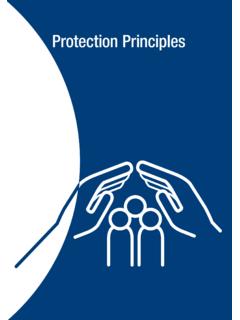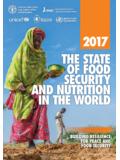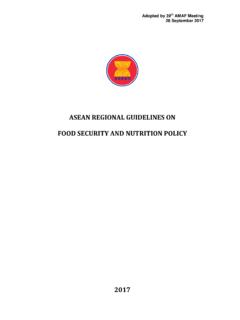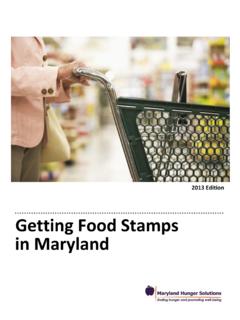Transcription of Minimum Standards in Food Security and nutrition
1 Minimum Standards in food Security and nutritionHumanitarian Charter and Minimum Standards in Humanitarian Response140 How to use this chapterThis chapter is divided into four main sections: food Security and nutrition assessmentInfant and young child feedingManagement of acute malnutrition and micronutrient deficienciesFood securityThe fourth section, food Security , is subdivided into three sections: food Security food transfers; food Security cash and voucher transfers; and food Security livelihoods The Protection Principles and Core Standards must be used consistently with this chapter Although primarily intended to inform humanitarian response to a disaster, the Minimum Standards may also be considered during disaster preparedness and the transition to recovery activities Each section contains the following: Minimum Standards .
2 These are qualitative in nature and specify the Minimum levels to be attained in humanitarian response regarding the provision of food and nutrition Key actions: These are suggested activities and inputs to help meet the Standards Key indicators: These are signals that show whether a standard has been attained They provide a way of measuring and communicating the processes and results of key actions; they relate to the Minimum standard, not to the key action Guidance notes: These include specific points to consider when applying the Minimum stan-dards, key actions and key indicators in different situations They provide guidance on tackling practical difficulties, benchmarks or advice on priority issues They may also include critical issues relating to the Standards , actions or indicators, and describe dilemmas, controversies or gaps in current knowledge If the required key indicators and actions cannot be met.
3 The resulting adverse implications for the affected population should be appraised and appropriate mitigating actions taken Appendices include checklists for assessments, guidance on measuring acute malnutrition and determining the public health significance of micronutrient deficiencies and nutritional requirements A select list of references, which points to sources of information on both general issues and specific technical issues and is divided into source material and further reading.
4 Is also provided Minimum S tandards in food S ecurity and nutrition141 ContentsIntroduction 14 31 food Security and nutrition assessment 1502 Infant and young child feeding 1583 Management of acute malnutrition and micronutrient deficiencies 1644 food Security 1754 1 food Security food transfers 1794 2 food Security cash and voucher transfers 1994 3 food Security livelihoods
5 203 Appendix 1: food Security and livelihoods assessment checklists 214 Appendix 2: Seed Security assessment checklist 216 Appendix 3: nutrition assessment checklist 218 Appendix 4: Measuring acute malnutrition 220 Appendix 5: Measures of the public health significance of micronutrient deficiencies 224 Appendix 6.
6 Nutritional requirements 227 References and further reading 231 Humanitarian Charter and Minimum Standards in Humanitarian Response142 Appendix 1: food Security and livelihoods assessment checklistsAppendix 2: Seed Security assessment checklistAppendix 3: nutrition assessment checklistAppendix 4: Measuring acute malnutritionAppendix 5: Measures of the public health significance of micronutrient deficienciesAppendix 6.
7 Nutritional requirementsFood Security and nutritionStandard 2 Basic and skilled support Standard 2 NutritionStandard 1 food securityStandard 1 General food Security Standard 1 Policy guidance and coordinationFood Security and nutrition assessment Infant and young child feeding Standard 3 Micronutrient deficienciesStandard 2 Severe acute malnutrition Standard 1 Moderate acute malnutritionManagement of acute malnutrition and micronutrient deficienciesStandard 5 Targeting and distributionStandard 6 food useStandard 2 Appropriateness and acceptabilityStandard 3 food quality and safetyStandard 4 Supply chain management (SCM)
8 Standard 1 General nutrition requirements food Security food transfersStandard 1 Access to available goods and servicesFood Security cash and voucher transfersStandard 2 Income and employmentStandard 3 Access to markets Standard 1 Primary production food Security livelihoodsFood Security References and further readingHumanitarian CharterProtection PrinciplesCore StandardsMinimum S tandards in food S ecurity and nutrition143 IntroductionLinks to the Humanitarian Charter and international lawThe Minimum Standards for food Security and nutrition are a practical expres-sion of the shared beliefs and commitments of humanitarian agencies and the common principles, rights and duties governing humanitarian action set out in the Humanitarian Charter.
9 Founded on the principle of humanity, and reflected in international law, these principles include the right to life with dignity, the right to protection and Security , and the right to receive humanitarian assistance on the basis of need. A list of key legal and policy documents that inform the Humanitarian Charter is available for reference in Annex 1 (see page 356), with explanatory comments for humanitarian states are the main duty-bearers with respect to the rights set out above, humanitarian agencies have a responsibility to work with the disaster-affected population in a way that is consistent with these rights.
10 From these general rights flow a number of more specific entitlements, including the rights to participation, information and non-discrimination that form the basis of the Core Standards as well as the specific rights to water, food , shelter and health that underpin these and the Minimum Standards in this has the right to adequate food . This right is recognised in international legal instruments and includes the right to be free from hunger. When individ-uals or groups are unable, for reasons beyond their control, to enjoy the right to adequate food by the means at their disposal, states have the obligation to ensure that right directly.









